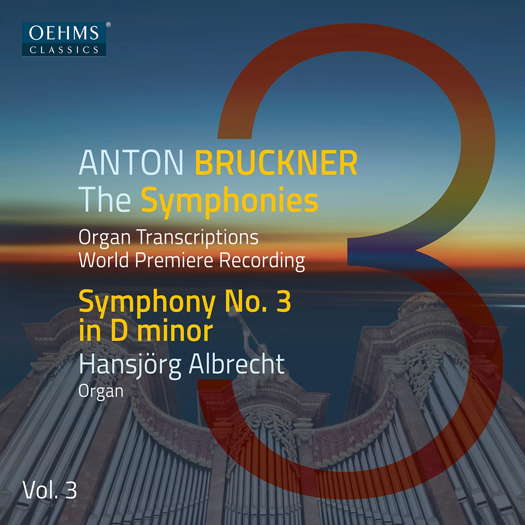
Bruckner the Trumpet
GERALD FENECH listens to Bruckner's Symphony No 3, transposed for organ
'... Hansjörg Albrecht's renditions of these spectacular transcriptions by Erwin Horn are absolutely flawless.'
Anton Bruckner (1824-1896) composed the first version of his third symphony in D minor in 1873. In September of that year, before the work was finished, Bruckner visited Richard Wagner, whom he had first met in 1865 at the premiere of Tristan und Isolde in Munich. Bruckner showed both his Second and Third symphonies to Wagner, asking him to choose one he preferred. To Bruckner's delight, Wagner chose the Third, and Bruckner dedicated the symphony to the master he highly respected. After arriving home, Bruckner continued to work on the symphony, finishing the finale on 31 December 1873. According to an anecdote, Bruckner and Wagner drank so much beer together that, upon arriving home, Bruckner realized he had forgotten which symphony Wagner had chosen. He wrote a letter back to Wagner saying, 'Symphony in D minor, where the trumpet begins the theme?' Wagner scribbled back, 'Yes! Best wishes! Richard Wagner'. After this, Wagner often referred to Bruckner as 'Bruckner the trumpet', and the two became firm friends.
Listen — Bruckner, transcribed Erwin Horn: Moderato (Symphony No 3)
(OC479 track 3, 0:00-0:59) ℗ 2021 OehmsClassics Musikproduktion GmbH :
In the dedication, Bruckner referred to Wagner as 'the unreachable world-famous noble master of poetry and music'. The 1873 version was rehearsed by the Vienna Philharmonic in June or July 1874, but it was not accepted for performance. The premiere of the symphony in the revised 1877 version was given in Vienna on 16 December 1877. The conductor was meant to be Johann von Herbeck, but Herbeck died a month before the concert, and Bruckner, reluctantly, stepped in to conduct his own work. The concert was a complete disaster due mainly to the composer's incompetent conducting. Indeed, Bruckner was a very decent choral conductor, but a barely competent orchestral one. The Viennese audience, which was not sympathetic to his work to begin with, gradually left the hall as the music played, and the orchestra fled at the end, leaving Bruckner alone with a few supporters, including Gustav Mahler. (It's interesting to know that the first three movements of the symphony were later owned by Mahler, and Alma, Gustav's widow, ensured she took the manuscripts with her when fleeing the Nazi invasion of France in 1940 for the United States.)
Shattered by this debacle, Bruckner made several revisions of his work, leaving out significant amounts of music including most quotations from Wagner's Tristan and Die Walküre. The 1873 score was not published until 1977. The work has a notorious reputation as being the most revised of Bruckner's symphonies, and there exist no fewer than six versions, with three of them being widely performed today. These are the original 1873 version, the 1877-78 version and the composer's last thoughts of 1889. The symphony can be described as 'heroic' in nature, and Bruckner's love for the grand and majestic is strongly reflected, especially in the first and last movements. Stark contrasts, cuts and forcefulness punctuate the entire piece, and the signal-like trombone theme, heard at the beginning after the two crescendo waves, constitutes a motto for the whole symphony. Many typical elements of the later symphonies, such as the cyclical penetration of all movements and especially the apotheosis at the coda of the finale, which ends with the trombone theme, are heard in the Third for the first time.
Listen — Bruckner, transcribed Erwin Horn: Ziemlich schnell (Symphony No 3)
(OC479 track 6, 13:00-13:57) ℗ 2021 OehmsClassics Musikproduktion GmbH :
The Symphonic Prelude in C minor is a sort of mystery piece, as we are not absolutely sure whether it is vintage Bruckner or otherwise. Composed in 1876, the work was discovered shortly after World War II. Heinrich Tschuppik, who found the orchestral score in the estate of Bruckner's pupil Rudolf Krzyzanowski, attributed the authorship to Bruckner. Thirty years later, Mahler scholar Paul Banks, who knew only a four-stave reduction of the work, proposed that the work might be attributed to Mahler. While the exact circumstances of the composition of this Prelude have not been determined, it is certain to have been composed within the Bruckner circle and his students at the Vienna Conservatory of Music. Based on the original orchestral score, it seems likely that the work was at least sketched by Bruckner, possibly as an exercise in orchestration for Krzyzanowski. Whatever the case, this 293-bar manuscript has strong shades of Bruckner's later works, particularly the Ninth Symphony. The second theme reflects ideas of the Third Symphony and the 'miserere' of the D minor Mass, while the rather short second part coda is merely a final cadence reflecting the closing theme as a repeated chain of minor seconds. In all, this Symphonic Prelude constitutes an extremely advanced experimental sonata movement, with a dramatic first part combining development, recapitulation and coda to a unified and radical second part.
Listen — Bruckner, transcribed Erwin Horn: Symphonic Prelude in C minor
(OC479 track 1, 0:01-0:57) ℗ 2021 OehmsClassics Musikproduktion GmbH :
This fourth release in this series marking the 200th anniversary of Bruckner's birth in 2024 is, like the previous three, a highly revealing experience that brings to light the extreme adaptability of Bruckner's music to the organ. This recording was made on the impressive organ of St Peter, Munich, and Hansjörg Albrecht's renditions of these spectacular transcriptions by Erwin Horn are absolutely flawless. Indeed, his technical prowess is nothing short of phenomenal, and the architectural beauty of Bruckner's towering score, despite being an organ transcription, is brought out with open-hearted conviction and immense stylistic detail.
For this mammoth project comprising ten CDs, Albrecht has commissioned composers with an affinity for Bruckner's work to create ten new 'Bruckner Windows'. This supports Albrecht's wider aim of expanding the contemporary organ repertoire, as well as providing a platform for contemporary composers. The work on this issue is PINUS Bruckner-Fenster by Johanna Doderer (born 1969), a short but evocative piece that fits the programme like a glove. A quite compelling addition to this pioneering undertaking which, I am sure, would have had the nod from the composer himself.
Listen — Johanna Doderer: PINUS Bruckner-Fenster
(OC479 track 2, 1:37-2:34) ℗ 2021 OehmsClassics Musikproduktion GmbH :
Warmly recommended, especially for Bruckner and organ buffs. Sound and presentation are first-rate.
Copyright © 24 March 2022
Gerald Fenech,
Gzira, Malta

CD INFORMATION - BRUCKNER: SYMPHONY NO 3 - HANSJÖRG ALBRECHT
CLASSICAL MUSIC ARTICLES ABOUT AUSTRIA
CLASSICAL MUSIC ARTICLES ABOUT GERMANY




